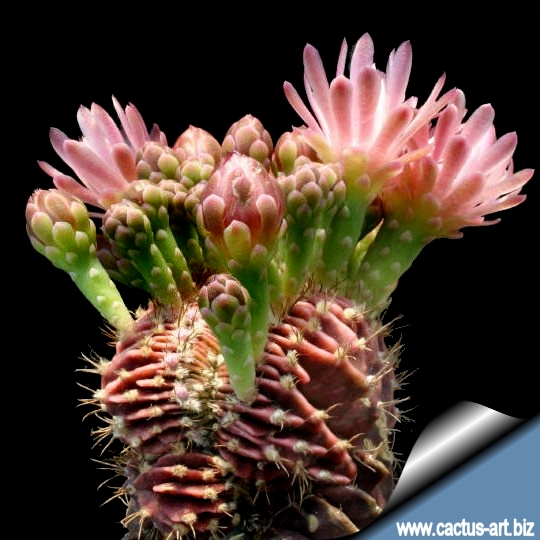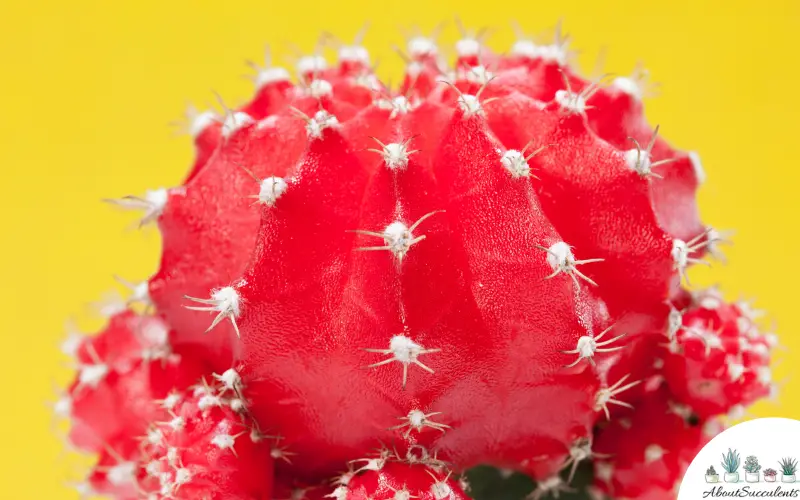
Repot: Repot in spring every year, generally cultivated for 3~5 years, the ball color pale aging, need to re-graft bulb renewal. On the basin floor should not be put pad basin tile, and should put a small amount of ceramsite. The pH should be slightly acidic to neutral, with a pH of 6.0~6.5. The culture soil of Moon cactus (Gymnocalycium mihanovichii) should be made up of peat, peat and clizia soil mixed with a small amount of perlite. Moon cactus (Gymnocalycium mihanovichii) should be watered at the right time except in winter, usually with moderate moisture or a little dry. There should be plenty of light except in the middle of summer. If the indoor temperature is low in winter, it should be kept relatively dry. Moon Cactus (Gymnocalycium mihanovichii) requires 60% to 75%. But can withstand high temperature of 40℃ and low temperature of 2℃ (in the case of basin soil drying). The optimum temperature for the growth of Moon Cactus (Gymnocalycium mihanovichii) was 15℃~32 ☌. (Read More: How Long Do Moon Cactus Live) Ecological Habits of Moon Cactus Temperature Moon cactus is native to eastern South America. The fruit of Moon Cactus (Gymnocalycium mihanovichii) is slender, spindle-shaped and red.Seeds black brown. (Read More about Moon Cactus Flower) Fruit moon cactus flowers can bloom in spring and summer. Moon Cactus flowers are long, slender, funnel-shaped and pink, bearing on the top of the spines.

The spines are small, without intermediate spines, and the radiation spines are short or detached. Stems are globose, 3-4 cm in diameter, bright red, dark red orange-red, pink or purplish red, 8-ribbed, with prominent transverse ridges. Moon Cactus (Gymnocalycium Mihanovichii) is a succulent perennial. The growing medium must be replaced once every 1-2 years and the soil should be kept quick-draining so a mixture that is high in sand and perlite is recommended (2).Morphological Characteristics of Moon Cactus Stems Repotting your cactus should be done with extra care since grafted plants, although established, tend to be more sensitive. The crown will eventually grow bigger and produce offsets so it needs to be regrafted to a new, bigger rootstock. The Dragon fruit cactus base is ideal because the triangular shape of the stem provides enough surface area that the scion can attach to and it is also an extremely adaptable plant. The Moon cactus needs to be grafted or it will not survive, especially during its vegetative state so a stable dark green rootstock is required not just to provide food but to anchor the plant too. However, grafted plants are found to be sensitive to too much water so it is safer to keep the soil on the drier side. Since the rootstock is an epiphytic plant, it should survive drought as well as slightly moist conditions.
GYMNOCALYCIUM MIHANOVICHII MINT CHOCOLATE CACTUS SERIES
A series of individually potted Moon cactus also make a striking display in this location (3). They are ideally placed on the windowsill where they can receive the less harsh morning sun. The Moon cactus needs bright light but not direct sunlight as this will cause the ball crown to scorch. Caring for this cactus is almost the same as when growing a Dragon fruit plant with some additional considerations to keep the Gymnocalycium looking its best.

Growing hotheads indoors may seem difficult being in a color-rich and grafted state but it is relatively easy that many enthusiasts begin with this plant. To survive, most neon cacti in the market are grafted onto a sturdy rootstock like the Hylocereus undatus so basically, what we consider a Moon cactus is a combination of two cacti (2). Since they lack the chlorophyll needed for their growth, they need the support of other greener and established cacti. Because of this, they are also called “hotheads”, “ruby ball”, and “neon cactus” (1).Īs independently striking as they can be, these cacti cannot stand on their own. One of the widely cultivated cacti in the genus, it was first introduced in Japan in 1948 offering collectors a range of colors and combinations like red, pink, orange, yellow, and purple. It is a 2-4 in (5-10 cm) globular cactus that got the name from its shape and the smaller “moons” or offsets that appear on the plant upon maturity.

friedrichii ‘Hibotan’ is the scientific name of the Moon cactus. If you’re looking for a splash of color in your cactus collection, this novelty plant is for you. But one species has made a name for its brightly bizarre stems and growth – the Moon cactus. They are not necessarily vibrant-looking and the colors are often brought about by their showy blooms. Most cacti come in different shades of green and although unique-looking, they can blend well with other plants, in the wild or indoors.

The cactus family is known for their distinct spines, areoles, and plump, often ribbed stems.


 0 kommentar(er)
0 kommentar(er)
